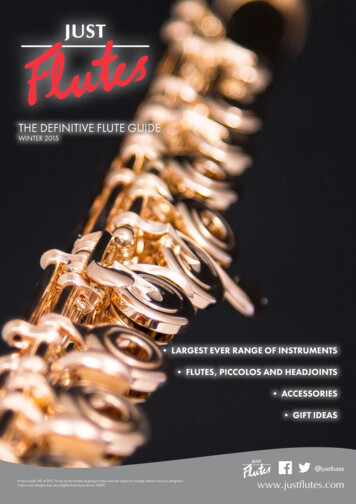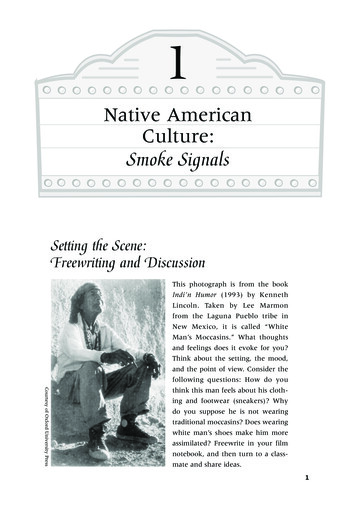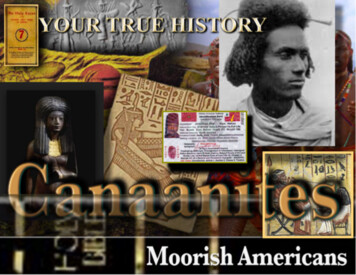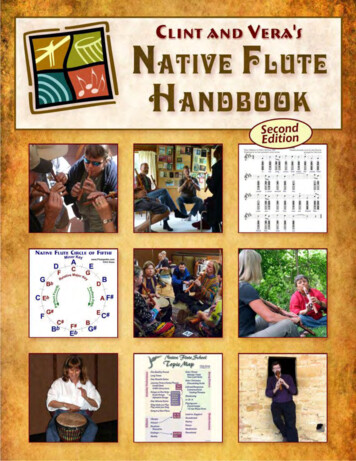
Transcription
Clint & Vera’s Native Flute Handbook1
2September 26, 2015
C lint & V era’s N ative F lute H andbookS econd E ditionCourse materials for participants of Native Flute Schools, Retreats,Workshops, and Gatherings facilitated by Clint and Veraby Clint Goss and Vera ShanovSeptember 26, 2015Private electronic distributionNot for sale or distributionCopyright 2015 by Clint Goss, All Rights Reserved.For information, contact Clint Goss at.Clint & Vera’s Native Flute Handbook3
For our current workshop schedule:http://www.ClintGoss.com/calendar.html4To sign up for our monthly lSeptember 26, 2015
Table of ContentsRight in Tune, Revisited . 57You can click on any of the page numbers totake you directly to that chapter.Preface . 7Back to Back . 63Active Listening . 65Playing (from the Heart)Over Changes . 69Alternate Scales . 73Part 1 – Flute PlayingOne-Breath Solos . 13Long Tones . 15The Scale Song . 17Right in Tune . 21No Pain, We Gain . 27The Rhythm Connection . 29A Scale Codex . 85This Is My Music . 89Widening the Circle . 93Nudge, Nudge . 97Cultural Insights . 101Your Brain on Flute . 107The Native American Fluteand the Future . 115Leaps . 31Note Endings . 35The Major Minor . 37I’m Sorry, So Sorry . 39Vibrato . 41Rhythmic Chirping . 45FluteCasts . 47Random Melodies . 49The Heavenly Rut . 53Clint & Vera’s Native Flute HandbookPart 2 – Flute Circle FacilitationWhat Is Our Job Title? . 119That’s OK, Clint . 121Warming Up . 123Deep Listening . 129Modeling . 135Rounding the Circle . 1375
A Bill of Musical Rights . 141Ode to Joy . 230Success for All . 143Origin Song of the Flageolet . 231Ensembles . 147Pokarekare Ana . 233Facilitating with Rhythm . 153Sakura . 235Keyboards in the Circle . 157Shenandoah . 239Music Theory Questions . 167Simple Gifts . 240Lessons on Lessons . 173Summertime . 242Exploring the Voice . 179Taps . 244Topic Map . 183Wendeyaho . 245Yaquis Deer Dance . 247Part 3 – RhythmsWorld Rhythms . 189You Are My Sunshine . 249Zuni Sunrise . 251Part 4 – Sheet MusicSheet Music Introduction . 211Amazing Grace . 212America . 214Bridal Chorus . 216By the Waters of Minnetonka . 217Colors of the Wind . 221Death Song of the Cherokee . 223Earth My Body . 224Hon Shirabe . 225The Huron Carol . 226Kayowajineh . 227Maliseet Love Song . 2286September 26, 2015
PrefaceThis handbook is based on a collection ofarticles we have developed over the past severalyears, assembled and edited specifically as anaid to participants attending our workshops,retreats, and gatherings (Flute Haven NativeFlute School, Flute Harvest Native FluteRetreat, Native Rhythms Flute School, etc).Each chapter is a typically based on a separatearticle, so each of the chapters can be readindependenly. They are also designed to be readstraight through, providing a graded, buildingblock approach.The first edition of this handbook – 190 pagesin length – was individually printed, bound, andprivately distributed to partcipants of our musicworkshops in 2014. This was rather laboriousand environmentally unfriendly. However, sincethis first edition of the book contained someelements that were only distributable under fairuse settings, a digital version was not an option.Many people have contributed to this material,especially my co-authors on some of thechapters: Lynn Miller, Eric Miller, and MaryKnysh. Kathleen Joyce-Grendahl, in her role aseditor for the INTERNATIONAL NATIVEAMERICAN FLUTE ASSOCIATION newsletterVoice of the Wind and the WORLD FLUTESOCIETY newsletter Overtones, providededitorial input on a number of the articles.Additional material and input has been providedby Randy Brody, Cornell Kinderknecht, R.Carlos Nakai, James Oshinsky, and manyothers. Individual co-authors and contributorsare noted at the footer of each chapter.In 2015, we removed copyright-restrictedcontent so that a digital distribution wasfeasible. The document was overhauled toreduce the size of the PDF distribution (70 MBto under 6.7 MB), provide clickable links toweb sites and a table of contents outline inAcrobat Reader, and to use fonts that arelicensed for distribution. The content was alsosubstantially updated to make corrections, addinformation on our workshop schedule, andinclude 14 new chapters based on articleswritten over the last year, which brought thePDF distribution size to 7.8 MB.A great deal of the material is based on mytraining at the MUSIC FOR PEOPLE organization(www.MusicForPeople.org), which is the primarybasis for the facilitation techniques that Veraand I use in Native Flute workshops.We hope you find this material useful!Clint & Vera’s Native Flute HandbookFirst EditionSecond EditionThis second edition comprises 252 pages in thedigital release. Note that this document stillretains aspects of the printed version: offset leftand right pages as well as blank pages toachieve the proper pagination for duplexprinting.7
Accessing the ContentThe Second Edition of the Native FluteHandbook can be read by version 6.0 or later ofAdobe Acrobat Reader and related products.This standard was released in July of 2003, somost up-to-date computer systems should beable to access this content.You can click on any of the hypertext links inthis document to access related content,including web pages, audio recordings, andother related PDF documents.The content of this handbook will likely changefrom time to time. Different editions of thishandbook may contain substantially differentcontent. For these reasons, rather thandistributing copies of this electronic file, pleaseaccess the latest version at:http://www.FluteHaven.com/nfh.htm orhttp://www.NativeFluteSchool.com/nfh.htmThis material is for your own personal use.Please do not make copies of this material ordistribute it in any form.— Clint Goss and Vera ShanovSeptember 26, 2015CitationsAlthough this handbook is designed to bepractical rather than academic, some of thechapters cite references and external sources.An example of a citation in the body of the textis [Author 2014]. You can find the details ofthe citations in a chapter at the end of thatchapter. Where possible, a related web site islisted.Most of the cited works are also listed in theextensive reference section on Flutopedia. Tobrowse the list of references on Flutopedia, raphyWe wanted to makereading this handbook aseasy and enjoyable aspossible, so we put someresearch and effort intolayout and selection oftypefaces.The body text of the firstedition of this handbookwas set in AdobeGaramond Pro, named forthe 16th century Frenchtype designer ClaudeGaramond. This version ofthe typeface was designedfor Adobe by RobertSlimbach. This font wasnot available fordistribution, so Times NewRoman is used for the bodytext as of the SecondEdition.8September 26, 2015
Titles of publications and publishedmaterial are written in italics, boldface isused for emphasis, and ORGANIZATIONS areshown in SMALLCAPS.Other fonts used in this handbook are:Chianti BT (typically in a bold-italic style) isused for most titles and headers. It was designedin 1991 by Dennis Pasternak of Bitstream toprovide a humanist san-serif font of highreadability.Gill Sans MT is used for Internet addresses. Thetypeface was developed in the 1920s by EricGill. This version was crafted in the early 1990sby Monotype.Tekton Pro was used in the First Edition foritems written in a drum or spoken language,such as “TaKaDiMi Sis Boom Bah – ”. Itwas designed as an informal typeface forarchitectural graphics and building construction.It was designed in 1989 by David Siegel ofAdobe, based on the hand-lettering of FrancisD.K. Ching, a Seattle-based architect and notedauthor on design and drawing. This font was notavailable for distribution, so Chianti BT is usedfor these elements as of the Second Edition.The fonts used for finger diagrams such asandare the NAFTracksseries of fonts. They are available on Flutopediaat http://www.Flutopedia.com/fonts.htm. Clint & Vera’s Native Flute Handbook9
10September 26, 2015
Part 1 –Flute PlayingClint & Vera’s Native Flute Handbook11
12September 26, 2015
One-Breath SolosThis is a wonderful technique that you can useas a warm-up, if you are developing a newsong, or if you would like to invite people at aflute circle to “musically” introduce themselves:Take a reasonably full breath and exhale intothe flute, playing a melody for the durationof your breath.When you try the exercise for the first time, youmight find that you tend to “run out of breath”.The goal is not to squeeze every last drop ofbreath out of your system, but to end the phrasewhen most of your breath is expired and youcan comfortably relax and let your lungsnaturally start to re-expand.After a while, you get to sense the duration ofyour breath, and build complete phrases to fitwithin that duration. For me, this is thefirst lesson in “song composition” therepeated, deep practice of playing withinour breath-span. Moving on to making an “ocean” sound inthe throat during the exhale, Then adding some soft vocalizations, Exhaling into the flute on a single, longsteady tone. And finally, “moving the fingers” – playing amelody of any sort within the span of thatone breath.In addition to the value of simply playing onebreath solos, they also become building blocksfor a lot of other exercises. They can be thebasis for playing duets as call and response –each person is playing one-breath solos. Ifyou're working on structured songs in AABAsong form -- Simply play a one-breath solo,The real challenge is, of course, todisconnect your brain. The more we tryto think about what we're going to play,the further we get from playing from theheart.In flute circles or workshops, we usuallydevelop this exercise as a group bybuilding up from the very basics: Starting from taking full breaths andsimply exhaling steadily,This chapter was written by Clint Goss. A similar article appeared in, October 2013.Clint & Vera’s Native Flute Handbook13
repeat it, play something else (the “B”) and thenplay the first one-breath solo again.Finally, there's another benefit if you're inleading a flute circle: If you'd like everyone toplay a short piece in turn, you could ask for aone-breath solo (or even “two one-breathsolos”), putting an implicit time limit on thesolos.14September 26, 2015
Long TonesHere is a wonderful exercise that I learned onmy flute path from Paul Butler, woodwindplayer extraordinaire: Long Tones. Thepractice is so simple and so perfect for NativeFlutes: Pick any fingering. For novice players, Ioften suggest three holes closed, three holesopen. Take a reasonably full breath. Breathe into the instrument for the fullduration of your breath, working towards asmooth, even sound with no variation involume. End the long tone when you are mostly, butnot completely, out of breath.Try making a “round” endingto the note, so that it drops offsmoothly and cleanly intosilence.hold in one hand. You might start this practiceon a flute with a fair amount of back-pressureand progress to flutes with less back-pressure.(“Back-pressure” or “breath pressure” is howmuch pressure the player feels in their mouthfrom the flute).While this exercise may sound simplistic,especially after you've been playing for a while,realize that many experienced andaccomplished woodwind players use this as acore daily practice. It's also a great exercise toget out of the “trying to play lots of notes”syndrome and help us return to the mode wherethis instrument shines – long held notes.The idea of long tone practice issimplicity: no vibrato, no fancyarticulation or attacks, no changein volume. And at the end, try notto be gasping for air, but end thenote while you still have a bit ofair remaining and before there isany tension for you to begin theinhale.If you have a choice of flutes touse for this exercise, pick a midrange flute that is comfortable toThis chapter was written by Clint Goss. A similar article appeared in, November 2013.Clint & Vera’s Native Flute Handbook15
Reflected SoundOne of the main goals of the long tone exerciseis listening to your sound. To hear your longtones better, you might try standing in front of awall so that the sound from the flute is reflectedback to your ears. If the foot of the flute isalmost touching the wall, you will get quit
Clint & Vera’s Native Flute Handbook 15 . Here is a wonderful exercise that I learned on my flute path from Paul Butler, woodwind player extraordinaire: Long Tones. The practice is so simple and so perfect for Native Flutes: Pick any fingering. For novice players, I
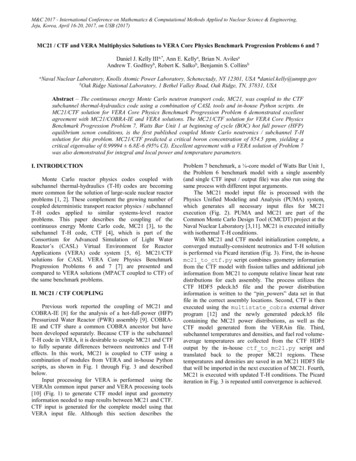
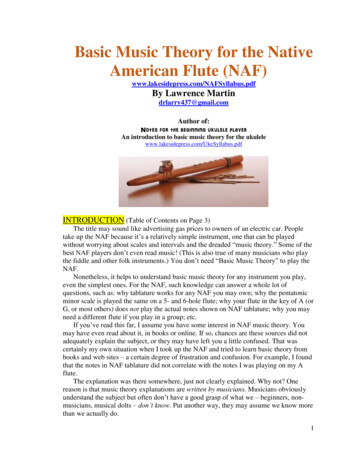
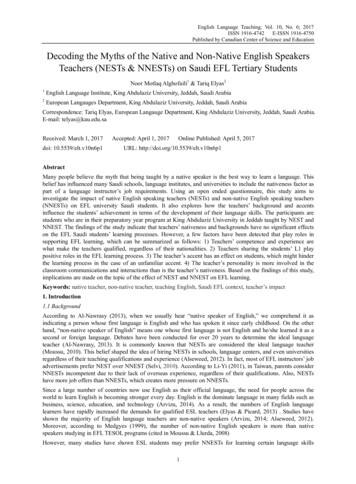

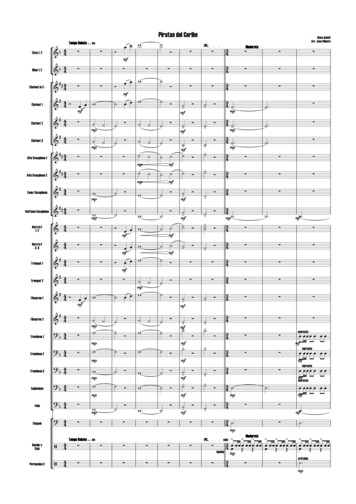
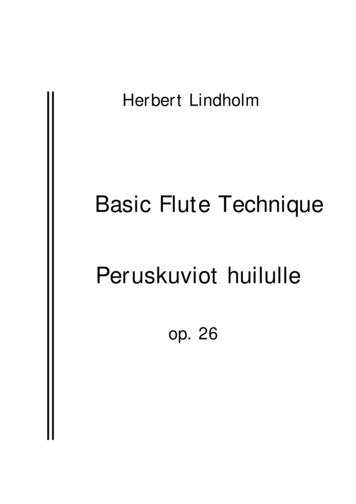
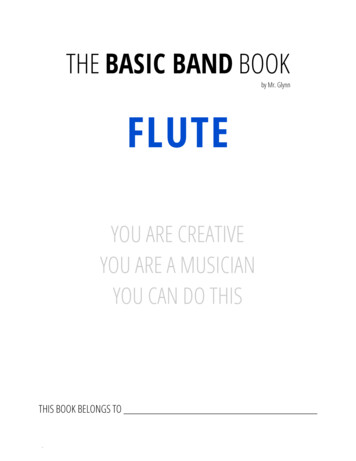
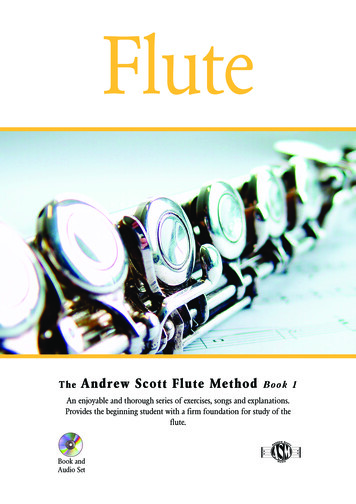
![Rubank elementary method : [for] flute or piccolo](/img/5/rubankelementary-flute.jpg)
